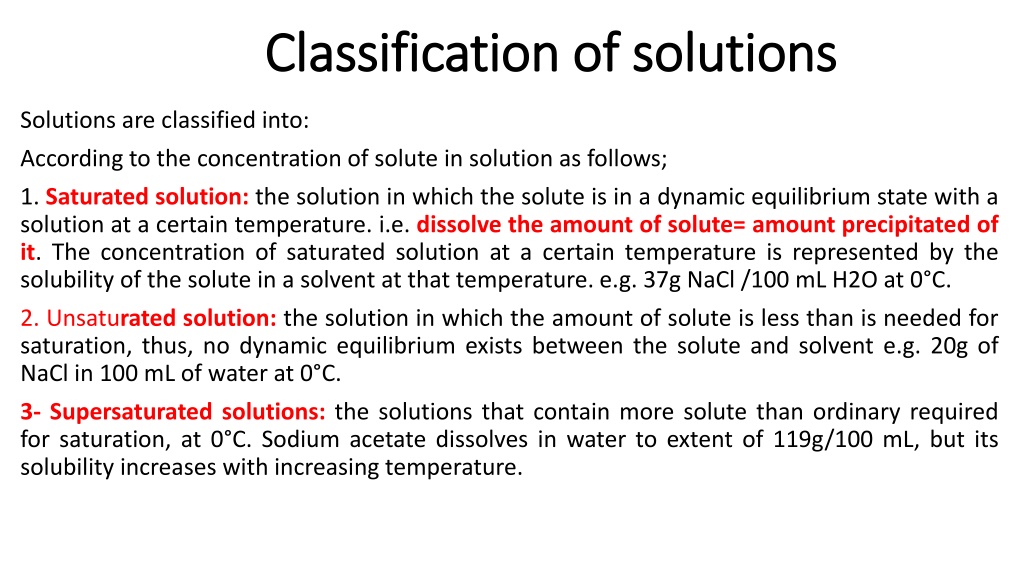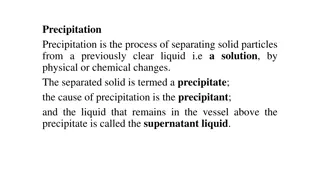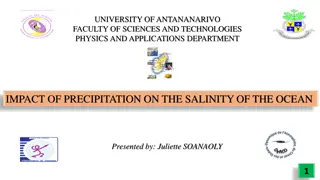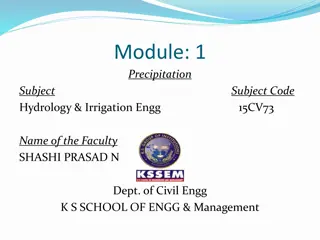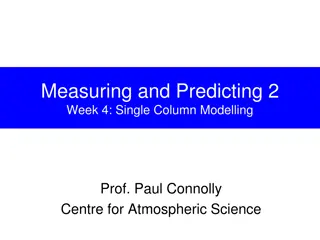Understanding Solutions and Precipitation Reactions
Solutions are classified as saturated, unsaturated, or supersaturated based on the concentration of solute in the solvent. Solubility plays a critical role in determining the amount of solute that can be dissolved in a solvent at a given temperature. Reactions yielding products of limited solubility are employed in analytical processes like separation, gravimetric analysis, and titrimetric analysis. Precipitation titrations involve the formation of insoluble precipitates through reactions in solution, which are vital for analytical chemistry applications.
Download Presentation

Please find below an Image/Link to download the presentation.
The content on the website is provided AS IS for your information and personal use only. It may not be sold, licensed, or shared on other websites without obtaining consent from the author. Download presentation by click this link. If you encounter any issues during the download, it is possible that the publisher has removed the file from their server.
E N D
Presentation Transcript
Classification Classification of of solutions solutions Solutions are classified into: According to the concentration of solute in solution as follows; 1. Saturated solution: the solution in which the solute is in a dynamic equilibrium state with a solution at a certain temperature. i.e. dissolve the amount of solute= amount precipitated of it. The concentration of saturated solution at a certain temperature is represented by the solubility of the solute in a solvent at that temperature. e.g. 37g NaCl /100 mL H2O at 0 C. 2. Unsaturated solution: the solution in which the amount of solute is less than is needed for saturation, thus, no dynamic equilibrium exists between the solute and solvent e.g. 20g of NaCl in 100 mL of water at 0 C. 3- Supersaturated solutions: the solutions that contain more solute than ordinary required for saturation, at 0 C. Sodium acetate dissolves in water to extent of 119g/100 mL, but its solubility increases with increasing temperature.
Solubility of precipitates Solubility of precipitates Solubility is the amount of solute needed to give a saturated solution with a given amount of solvent. Thus, the solubility of NaCl in water at 0 C is 37g/100mL. Usually solute's solubility changes with temperature. For example at 100 C the solubility of NaCl is 39.1g/100mL of H2O.this means that we should always specify the temperature when stating the solubility.
Reactions that yield products of limited solubility find application in three important analytical processes: 1. The separation of an analyte as a precipitate from soluble substances that would otherwise interfere with ultimate measurement. 2. Gravimetric analysis, in which the precipitate is formed whose weight is chemically related to the amount of analyte. 3. Titrimetric analysis, based on the determination of volume of a standard reagent required precipitating the analyte essentially completely. The success of each of these applications requires that the solids produced have a relatively low solubility, be reasonably pure, and have a suitable particle size.
PRECIPITATION TITRATION Precipitation Reaction: - Reactions occurring in solution may produce substances that are insoluble in the solution and thus eventually settle to the bottom or "precipitate" out. - Typically precipitation reactions occurs in aqueous solutions between ions (i.e., the reactants are electrolytes). Often only one pair of ions actually reacts or precipitates while the other pair remains in the solution unchanged. Precipitation Titrations A reaction in which the analyte and titrant form an insoluble precipitate also can form the basis for a titration. We call this type of titration a precipitation titration. The meaning of ANALYTE is a chemical substance that is the subject of chemical analysis. The meaning of TITRANT is a substance (such as a reagent solution of precisely known concentration) that is added in titration.
Precipitation= Reaction that results in the formation of an insoluble product (precipitate) Precipitate= insoluble solid that separates from solution Metathesis/ double-displacement reaction = reaction that involves the exchange of parts between two compounds Example: Precipitation of Lead Iodide Pb(NO3)2(aq) + 2NaI (aq) PbI2(s) + 2NaNO3(aq) Yellow precipitate (insoluble) PbI2
PRECIPITATION TITRATION Precipitation Reactions A precipitation reaction occurs when two or more soluble species combine to form an insoluble product that we call a precipitate. The most common precipitation reaction is a metathesis reaction, in which two soluble ionic compounds exchange parts. When a solution of lead nitrate is added to a solution of potassium chloride, for example, a precipitate of lead chloride forms. We usually write the balanced reaction as a net ionic equation, in which only the precipitate and those ions involved in the reaction are included.
Precipitation Reactions Precipitation is the formation of a solid in a solution solid formed is called the precipitate A precipitation reaction occurs when water solutions of two different ionic compounds are mixed and an insoluble solid separates out of the solution. KCl + AgNO3 AgCl + KNO3 Cl- solution Precipitating White agent precipitate The precipitate is itself ionic; the cation comes from one solution and the anion from another.
Solubility product (Ksp): The solubility product constant, Ksp , is the equilibrium constant for a solid substance dissolving in an aqueous solution. It represents the level at which a solute dissolves in solution. The more soluble a substance is, the higher the Ksp value it has. When a compound is referred to as insoluble, its not completely insoluble but is slightly soluble. When substances have a limited solubility and their solubility is exceeded, the ions of the dissolved portions exist in equilibrium with a solid material. So-called "insoluble" compounds generally exhibit this property.
The precipitate will have a definite solubility (i.e., a definite amount that will dissolve) in g/dm-3or mol/dm-3at a given temperature (a saturated solution). A small amount of un-dissolved compound usually exists in equilibrium in the aqueous phase (e.g., on the order of 0.1%) and its concentration is constant. It is difficult to measure the un-dissociated molecule, and we are interested in the ionized form, presence of any un-dissociated species can generally be neglected. AgCl {??????} {????????} Ag++ Cl- Keq = + } Keq = ?? {?? {????} Since the concentration of a solid is a constant value that does not depend on temperature, pressure, or the presence of the solution in contact with it and can be neglected, , we simplify the above equation to.
[Ag+] [Cl-] = Keq [AgCl ] = constant This constant called constant of solubility product: Ksp = Keq = [Ag+] [Cl-] Every substance that is poorly soluble in water has its own solubility product Salt that has a lower Ksp value is the one that precipitates first, that is, if it has a low Ksp value, it indicates that the solubility of the salt is low.
